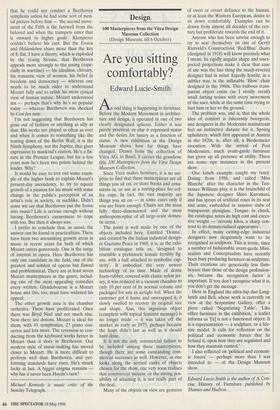Design
100 Masterpieces from the Vitra Design Museum Collection (Design Museum, till 6 October)
Are you sitting comfortably?
Edward Lucie-Smith
An odd thing is happening to furniture. Before the Modern Movement in architec- ture and design, it operated in one of two clearly designated spheres. Either it was purely practical, or else it expressed status and the desire for luxury as a function of status. A new exhibition at the Design Museum shows how far things have changed. Drawn from the collection of Vitra AG, in Basel, it carries the grandiose title 100 Masterpieces from the Vitra Design Museum Collection.
Since Vitra makes furniture, it is no sur- prise to find that these masterpieces are all things you sit on, or store books and orna- ments in, or use as a resting-place for cof- fee cups. In fact, the vast majority are things you sit on — in some cases only if you are brave enough. Chairs are the most fully three-dimensional and the most anthropomorphic of all large-scale domes- tic items.
The point is well made by one of the objects included here. Entitled 'Donna', and created by the Italian industrial design- er Gaetano Pesce in 1969, it is, as the exhi- bition catalogue tells us, 'designed to resemble a prehistoric female fertility fig- ure, with a ball attached to symbolise cap- tivity'. It embodied the very newest technology of its time. Made of dense foam-rubber, covered with elastic nylon jer- sey, it was reduced in a vacuum chamber to only 10 per cent of its normal volume and packaged for sale in airtight foil. When the customer got it home and unwrapped it, it slowly swelled to recover its original size and shape. Alas, this ingenious object (complete with topical feminist message) is no longer made — it was taken off the market as early as 1973, perhaps because the foam didn't last as well as it should have done.
It is not the only commercial failure to be included among these masterpieces, though there are some outstanding com- mercial successes as well. However, as one looks along the serried ranks of objects chosen for the show, one very soon realises that commercial success, or the strong pos- sibility of attaining it, is not really part of the deal.
Many of the objects on view are gestures of overt or covert defiance to the human, or at least the Western European, desire to sit down comfortably. Examples can be drawn from almost all decades of the cen- tury but proliferate towards the end of it.
Anyone who has been unwise enough to try to seat themselves on one of Gerrit Rietveld's Constructivist 'Red/Blue' chairs (designed in 1918) will know precisely what I mean. Its rigidly angular shape and unex- pected projections make it clear that ease of use was the last thing the much-revered designer had in mind. Equally hostile, in a subtler way, is the inflatable 'Blow' chair designed in the 1960s. This bulbous trans- parent object emits (as I vividly recall) small farting noises with every movement of the user, while at the same time trying to hurl him or her to the ground.
The problem was, and is, that the whole idea of comfort is inherently bourgeois, and designers in the Modernist mainstream feel an instinctive distaste for it. Sprung upholstery, which first appeared in Austria in the 1820s, is, after all, a Biedermeier invention. With the arrival of Post Modernism, much avant-garde furniture has given up all pretence at utility. There are some ripe instances in the present show.
One kitsch example caught my fancy. Dating from 1988, and called 'Miss Blanche' after the character in the Ten- nessee Williams play, it is the brainchild of the Japanese designer Shiro Kuromata, and has sprays of artificial roses in its seat and arms, embedded in massive slabs of transparent plexiglass. Tongue in cheek, the catalogue notes its high cost and exces- sive weight — 'seventy kilos, a sharp con- trast to its dematerialised appearance'.
In effect, many cutting-edge industrial designers now desperately want to be recognised as sculptors. This is ironic, since a number of fashionable avant-garde Mini- malists and Conceptualists have recently been busy producing furniture-as-sculpture. Their creations are generically less flam- boyant than those of the design profession- als, because the recognition factor is important. If you don't recognise what it is, you don't get the message.
Here in England the ultra-hip duo Lang- lands and Bell, whose work is currently on view at the Serpentine Gallery, offer a piece called 'Negotiating Table'. 'Like other furniture in the exhibition,' a leaflet informs us lit] is not a functional object. It is a representation — a sculpture, or a life- size model. It calls for reflection on the political and economic forces that lie behind it, upon how they are regulated and how they maintain control.'
I also reflected on 'political and econom- ic forces' — perhaps more than I was intended to — at the Design Museum show.
Edward Lucie-Smith is the author of A Con- cise History of Furniture published by Thames and Hudson.


































































 Previous page
Previous page